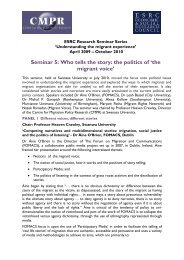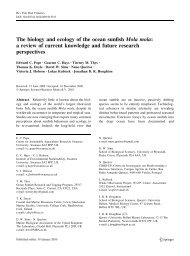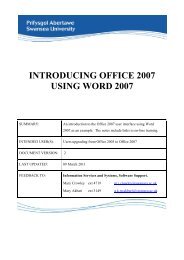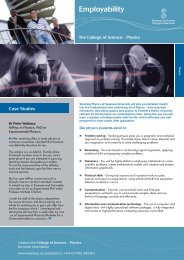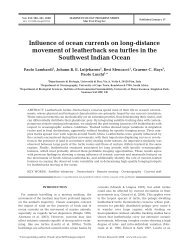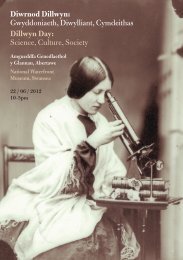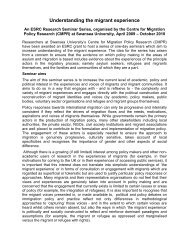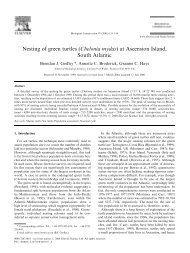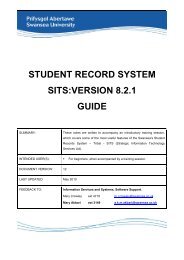The energy density of jellyfish - Swansea University
The energy density of jellyfish - Swansea University
The energy density of jellyfish - Swansea University
Create successful ePaper yourself
Turn your PDF publications into a flip-book with our unique Google optimized e-Paper software.
T.K. Doyle et al. / Journal <strong>of</strong> Experimental Marine Biology and Ecology 343 (2007) 239–252<br />
241<br />
samples (component plus aluminium carton) were<br />
weighed and then placed in an oven at a constant<br />
temperature <strong>of</strong> 65 °C and dried to constant mass. During<br />
the drying process, samples were removed and weighed<br />
once or twice a day. Prior to weighing, samples were<br />
first allowed to cool to room temperature in a desiccator,<br />
and immediately after weighing returned to the oven if a<br />
constant mass had not been achieved. On occasions it<br />
was necessary to ‘scrape and stir’ the sample to remove<br />
or prevent a surface layer (skin) forming that slowed the<br />
drying process. As large granules sometimes formed<br />
during this process, it was necessary to use a mortar and<br />
pestle to grind these samples into a fine powder. <strong>The</strong>se<br />
ground samples were then returned to the oven for<br />
additional drying.<br />
2.2. Determination <strong>of</strong> gross <strong>energy</strong> (GE) using<br />
bomb-calorimetry<br />
<strong>The</strong> gross <strong>energy</strong> (GE) was determined for individual<br />
tissue samples <strong>of</strong> C. capillata (n=25), R. octopus<br />
(n=17), and C. hysoscella (n =29) using a Gallenkamp<br />
Autobomb adiabatic calorimeter. <strong>The</strong> calorimeter had<br />
two stainless steel bombs and two calorimeter chambers,<br />
A and B. Each bomb was always used with the same<br />
calorimeter chamber during GE determinations. <strong>The</strong><br />
heat capacity (hc) <strong>of</strong> each separate pair <strong>of</strong> bomb and<br />
calorimeter chamber, plus the mass <strong>of</strong> water within the<br />
calorimeter chamber, was determined as follows: hc=<br />
[(GE ×wt)+0.167] /ΔT. Where, hc=heat capacity <strong>of</strong><br />
bomb (kJ °C − 1 ), GE=gross <strong>energy</strong> <strong>of</strong> benzoic acid<br />
(26.46 kJ g − 1 ), wt=weight <strong>of</strong> pellet in grams and<br />
ΔT=final temperature−initial temperature (in °C). <strong>The</strong><br />
heat capacity for each bomb chamber was 10.822 kJ °C.<br />
As is standard practice in adiabatic bomb calorimetry<br />
methodology, the same mass <strong>of</strong> water (±0.5 g) was<br />
always used for each bomb and calorimeter chamber<br />
pairing between GE determinations in order to maintain<br />
a constant heat capacity.<br />
Each chamber was also calibrated for the heat <strong>of</strong><br />
combustion <strong>of</strong> 1 g <strong>of</strong> benzoic acid (26.46 kJ g − 1 )ona<br />
daily basis. Typically, 0.70 g <strong>of</strong> sample material (e.g.<br />
food or animal tissue) would be combusted for<br />
determination <strong>of</strong> GE in this system. However, to ensure<br />
combustion <strong>of</strong> the ground <strong>jellyfish</strong> samples, 0.50 g <strong>of</strong><br />
sample was mixed with 0.50 g <strong>of</strong> benzoic acid in a<br />
weighing boat to give a composite sample, and<br />
manually pelleted using a hydraulic pelleting press<br />
(Enerpac). Once pelleted, samples were kept in a<br />
silica gel dessicator. <strong>The</strong> change in temperature to a<br />
constant temperature due to combustion <strong>of</strong> the sample<br />
(approximately 10 min post-ignition) was detected using<br />
a Beckmann thermometer, accurate to 0.001 °C. <strong>The</strong> GE<br />
<strong>of</strong> each composite sample was determined using<br />
standard procedures (McLean and Tobin, 1987) and<br />
calculated as; GE=[(TrK×K10.822/sample weight) K<br />
kJ g − 1 ]. Where Tr is the change in temperature <strong>of</strong> the<br />
calorimeter between initial and post-combustion <strong>of</strong> the<br />
sample, and 10.882 (kJ °C − 1 ) is the heat capacity<br />
constant for the chambers. <strong>The</strong> GE value was corrected<br />
for the contribution that 0.50 g <strong>of</strong> benzoic acid made to<br />
the combustion <strong>of</strong> the composite sample, to give the<br />
equivalent <strong>of</strong> a 1 g <strong>jellyfish</strong> sample. As is standard<br />
practice, the GE values were not corrected for the<br />
potential small effect <strong>of</strong> nitric or sulphuric acid formed<br />
during the combustion process (McLean and Tobin,<br />
1987).<br />
2.3. Proximate-composition analysis<br />
2.3.1. Ash determination<br />
<strong>The</strong> inorganic matter or ash content <strong>of</strong> samples was<br />
determined for individual tissues samples <strong>of</strong> C. capillata<br />
(n=39) and R. octopus (n=8) using the AOAC 16.267<br />
method (AOAC, 1990). Insufficient sample material <strong>of</strong><br />
C. hysoscella prevented similar ash/proximate composition<br />
analysis for this species. A known mass <strong>of</strong> sample<br />
(∼1 g±0.1 mg) that had been dried to constant mass,<br />
was ashed in a furnace at 600 °C for 6 h. <strong>The</strong> ash content<br />
was calculated by the difference between initial and<br />
final mass <strong>of</strong> the sample. Analysis was carried out in<br />
triplicate per sample.<br />
2.3.2. Protein, lipid and carbohydrate determination<br />
for individual tissue samples<br />
<strong>The</strong> protein content was determined for individual<br />
tissue samples <strong>of</strong> C. capillata (n=47) and R. octopus<br />
(n=8) using the macro-Kjeldahl method (Association <strong>of</strong><br />
Official Analytical Chemists (AOAC, 1990) method,<br />
International Dairy Federation (IDF) Standard 20B:<br />
1993). For calculation <strong>of</strong> the % protein in a sample, the<br />
% N was multiplied by a conversion factor <strong>of</strong> 5.8<br />
(Gnaiger and Bitterlich, 1984; Clarke et al., 1992). All<br />
protein analysis was carried out in triplicate.<br />
<strong>The</strong> fat content <strong>of</strong> individual tissues was determined<br />
for C. capillata (n=9) and R. octopus (n=7) using a<br />
Soxtec 2055 Avanti instrument (Foss, Ireland). All fat<br />
analyses were carried out in duplicate.<br />
<strong>The</strong> carbohydrate content <strong>of</strong> the samples was<br />
determined colorimetrically by measuring glycogen<br />
content (Cary Varian UV–Visible spectrophotometer)<br />
after acid digestion <strong>of</strong> individual tissue samples <strong>of</strong><br />
C. capillata (n=9) and R. octopus (n=7). All carbohydrate<br />
analysis was carried out in duplicate.



